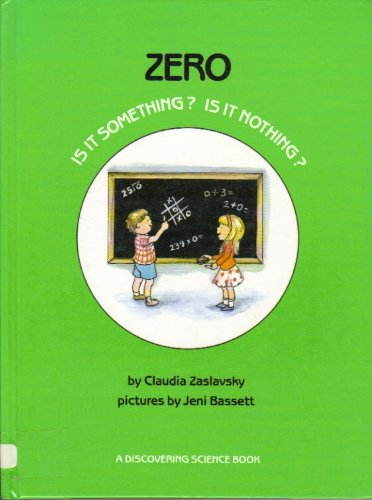-
Thomas Edison and Electricity
Steve Parker
Library Binding (Chelsea House Pub, April 1, 1995)Details the life and work of Thomas Edison, who developed such inventions as the stock ticker, the light bulb, and the phonograph T
T
-
Zero: Is It Something? Is It Nothing?
Claudia Zaslavsky, Jeni Bassett
Library Binding (Franklin Watts, April 1, 1989)Discusses the meaning and mathematical possibilities of the number zero P
P
-
Discover Science: Oceans and Seas
Nicola Davies
Paperback (Kingfisher, April 16, 2013)Make science accessible with this essential series that will capture children's imagination while laying the foundation for future learning. With age-appropriate language and an eye-catching design,Discover Science gives young readers the answers to fundamental questions about the human body, animals, planet Earth and the Solar System.Go on a breath-taking tour of the wide oceans and seas with Discover Science: Oceans and Seas by Nicola Davies.There is a lot to discover in the ocean―after all, two -thirds of Earth is covered by water! What kinds of animals live in shallow tropical reefs; what creatures lurk near the deepest ocean floor? How do humans affect sea life, and what mysteries are scientists still trying to solve? A parent and teacher guide, craft activities, and a glossary and index enhance this useful reference book. P
P
-
Discover Science: Robots
Clive Gifford
Hardcover (Kingfisher, Aug. 16, 2011)Make science accessible with this essential series that will capture children's imagination while laying the foundation for future learning. With age-appropriate language and an eye-catching design, Discover Science gives young readers the answers to fundamental questions about the human body, animals, planet Earth and the Solar System. In today's wired world, robots are everywhere: in the movies, on TV, in space, in computer games. Discover Science: Robots by Clive Gifford introduces the concept of a robot, and examines the many uses of robots in science, entertainment and industry. Definitions of new words are provided on each page, and at the end children can do one of three hands-on activities to create their own robots. O
O
-
Charles Darwin and Evolution
Steve Parker
Hardcover (Harpercollins Childrens Books, June 1, 1992)An illustrated biography of Darwin features paintings, photographs, and prints and discusses Darwin's shy boyhood in Shrewsbury, England, his voyages to South America, and his revolutionary evolutionary theories. P
P
-
The Great Penguin Rescue: Saving the African Penguins
Sandra Markle
Library Binding (Millbrook Press TM, Aug. 1, 2017)African penguins waddle around nesting colonies in lower numbers than ever before. Despite South African government efforts to protect the penguin colonies and their ocean fish supply, young penguins still struggle to survive. Fuzzy chicks waiting for food in open nests may overheat in the sun or become prey. Others simply may not get enough food to survive on their own once their parents leave. But new conservation methods, including rescuing and hand-feeding vulnerable chicks, are giving experts hope. Can volunteers and scientists help save Africa's only penguins before it's too late? V
V
-
Discover Science: Deserts
Nicola Davies
Hardcover (Kingfisher, Aug. 21, 2012)Come explore the world's deserts, from the scorching North American southwest to the cold Gobi. Starting with natural forces such as wind and rain and moving through plant and animal life, as well as all the ways humans live and work with the desert, this is an accessible introduction to this fascinating environment. With included hands-on activities and key vocabulary defined in the glossary, Discover Science: Desert by Nicola Davies is a clear, easy-to-understand introduction to an important environmental topic. N
N
-
Discover Science: Birds
Nicola Davies
Hardcover (Kingfisher, April 24, 2012)Birds are a wonderful entry point for a first study of animal life. Discover Science: Birds by Nicola Davies introduces young readers to the essential features of their fine-feathered friends, such as how birds fly, feed, communicate, reproduce, and raise their young. Kids will love the simple hands-on projects, and the eye-popping photography that takes them right up close. P
P
-
Galileo and the Universe
Steve Parker
Hardcover (Harpercollins Childrens Books, June 1, 1992)An illustrated biography of Galileo features paintings, photographs, and prints and discusses his early life as a young boy in Pisa, his revolutionary thinking in mathematics and astronomy, and more. Z
Z
-
How things work
Ian Graham
Paperback (Barnes & Noble, Jan. 1, 2003)Text and drawings explain the workings of certain everyday items including bicycles, traffic lights, and computers.
-
Rocks and Fossils
Chris Pellant
Hardcover (Kingfisher, Aug. 16, 2011)Make science accessible with this essential series that will capture children?s imagination while laying the foundation for future learning. With age-appropriate language and an eye-catching design, Discover Science gives young readers the answers to fundamental questions about the human body, animals, planet Earth and the Solar System. A bright and age-appropriate introduction to the three basic forms of rock, crystals, and fossils that includes information about geological processes like erosion and weathering, and examples of the many ways we use rock. Key vocabulary is defined on each page and three "Things to Make and Do" activities add a fun element of hands-on-learning. W
W
-
Discover Science: Polar Lands
Margaret Hynes
Hardcover (Kingfisher, Aug. 21, 2012)Discover Science: Polar Lands by Margaret HynesYoung readers are invited on a journey to the coldest places on Earth. Through the eye-catching photography and gentle text, readers will discover the polar world of light and dark, see the amazing adaptations that plants and animals (and humans) have made to survive in frigid climates, and learn about exploration, research, and protecting this remarkable environment. At the end they can investigate further by making their own snowflakes, icebergs, and more. O
O